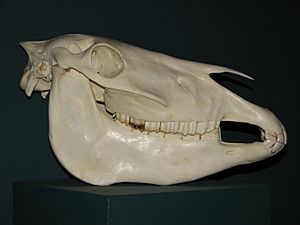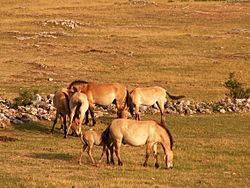Przewalski's horse facts for kids
Quick facts for kids Przewalski's horse |
|
|---|---|
 |
|
| Conservation status | |
| Scientific classification | |
| Kingdom: | |
| Phylum: | |
| Class: | |
| Order: | |
| Family: | |
| Genus: | |
| Subgenus: |
Equus
|
| Species: | |
| Subspecies: |
E. f. przewalskii
|
| Trinomial name | |
| Equus ferus przewalskii (Poliakov, 1881)
|
|
 |
|
| Range map | |
The Przewalski's horse (pronounced "sheh-VAL-skee's horse") is a special type of wild horse. It is also known as the Mongolian wild horse. This horse is a close relative of the horses we see on farms today. In fact, it is the only type of wild horse that can have babies with a domestic horse, and those babies can also have their own foals!
This amazing animal is a very rare and endangered type of wild horse. It originally comes from the wide, grassy plains called steppes in central Asia, especially in Mongolia. For a while, Przewalski's horses disappeared from the wild. Luckily, people brought them back from zoos and released them into their natural homes in Mongolia. Now, you can find them living freely in several nature reserves and national parks. In 2002, there were about 1,000 of these horses around the world.
Contents
What Makes Przewalski's Horses Unique?
Przewalski's horses look a bit different from regular domestic horses. They are built more strongly and have shorter legs. They usually stand about 12 to 14 hands tall, which is about 1.2 to 1.4 meters. They can weigh around 300 kilograms (about 660 pounds).
Their fur is usually a sandy or yellowish-brown color, called "dun." It's darker around their neck and mane, which stands straight up. Their bellies and around their noses are a lighter, yellowish-white. Sometimes, their legs have faint stripes, which is a common sign of ancient horse markings. Their tails are about 90 centimeters (3 feet) long, with shorter hair than you might see on a domestic horse's tail.
The hooves of Przewalski's horses are also special. They are longer at the back and have very thick soles. This helps their hooves work better in their wild environment. Interestingly, Przewalski's horses have 66 chromosomes, while all other horse types have 64.
How Przewalski's Horses Live and Behave
In the wild, Przewalski's horses live in small, lasting family groups. Each group usually has one adult male horse (called a stallion), one to three female horses (mares), and their young. The young horses stay with their family until they are about two or three years old. Young male horses who don't have a family yet, or older stallions, often form their own "bachelor" groups. Sometimes, several family groups will join together to form a larger herd that moves around together.
Their daily lives are much like those of other wild horse herds. The stallion protects all the horses in his family. The mares often lead the group. Stallions and mares tend to stay with the same partners for many years.
These horses always keep an eye on their family and herd. They have many ways to talk to each other. They use sounds, special smells, and lots of body language. Every kick, groom, or ear flick is a way for them to communicate. This constant communication helps them have complex social lives.
What Przewalski's Horses Eat
Przewalski's horses mostly eat plants. They live in areas with many different types of plants. While they eat a variety of plants, they often prefer certain ones depending on the time of year. This means they have favorite foods for each season.
For example, in spring, they like to eat Elymus repens (couch grass) and some other grasses. In early summer, they enjoy Dactylis glomerata (orchard grass) and Trifolium (clover). In late summer, they go back to eating Elymus repens and Vicia cracca (vetch). During winter, they eat things like Salix (willow) and Pinus sylvestris (Scots pine). They might even dig under the snow and ice to find grasses like Festuca (fescue). Their winter diet is quite similar to what domestic horses eat. In winter, their bodies slow down, and they eat their food more slowly.
Overall, the plants they eat most often are Elymus repens, Trifolium pratense (red clover), Vicia cracca, and several types of grasses like Poa trivialis and Bromus inermis.
Przewalski's Horses: Truly Wild Animals
Most "wild" horses you hear about today, like the American mustang or the Australian brumby, are actually feral horses. This means they are descended from domestic horses that escaped and learned to live in the wild. But the Przewalski's horse is different. It has never been successfully tamed by humans. It is a truly wild animal.
The Przewalski's horse is one of three known types of Equus ferus, which is the wild horse species. The other two are the domesticated horse (Equus ferus caballus) and the tarpan (Equus ferus ferus), which is now extinct. This makes the Przewalski's horse the only real wild "horse" left in the world. There are other wild animals in the horse family, like three types of zebra and different kinds of African wild ass, onager, and kiang.
How They Relate to Domestic Horses
Even though Przewalski's horses can have babies with domestic horses, they have an extra pair of chromosomes. This is a key difference.
Scientists have studied their DNA and found that Przewalski's horses are not the direct ancestors of modern domestic horses. There are also clear differences in how they look. For example, Przewalski's horses shed their tail and mane hair once a year, which domestic horses do not. So, while they are very closely related and have mixed in the past, the difference in their chromosome numbers shows they are distinct groups.
Przewalski's Horses in Zoos
Zoos have played a very important role in saving the Przewalski's horse. For a time, these horses only existed in zoos. Thanks to breeding programs in zoos, their numbers grew enough to allow them to be reintroduced to the wild. According to a system called ISIS, about 480 Przewalski's horses were reported living in captivity.
Images for kids
See also
 In Spanish: Caballo de Przewalski para niños
In Spanish: Caballo de Przewalski para niños









